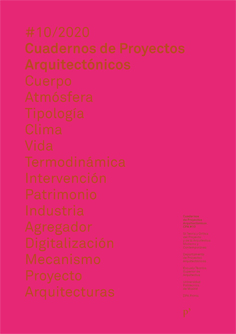The aggregator as a project. The case of BRUTHER
DOI:
https://doi.org/10.20868/cpa.2020.10.4574Palabras clave:
Aggregator, BRUTHER, Multitude, Architectural design, AtlasResumen
This article draws an analogy between the aggregator, a digital format based on the dynamic collection of external contents, and three works by the French office BRUTHER: a theoretical project of 2018 published in the Cartha journal, its manifesto in 99 notes and the New Generation Research Center in Caen. The analogy is based on the proposals set by art critic David Joselit, for whom the aggregator is a format which, due to its omnipresence in the contemporary media ecology, transfers its logic to many other spheres, including art and creation. These logics promote the gathering of differentiated entities in a common space and surface, something which results in forms that do not exhibit defined hierarchies nor completion, but foster multiple and individualized approaches. As reflected in the manifesto of the French office, BRUTHER’s work is also established on the gathering of unique, differentiated material and imaginary references, the meeting of which seeks to mobilize new ideas and design intuitions. The works published in Cartha and the Research Center are presented here as two products stemming from this logic: architectures generated from the collection of materials of diverse origin and of level importance that, in their coexistence, feed the generation of curiosities, intuitions and spatial scenarios.Descargas
Referencias
BRUTHER. “99 notes.” 2G 76 (2017): 142-152.
BRUTHER. “Framing the Disorder.” 2G 76 (2017): 157-159. BRUTHER. “New Generation Research Center, Caen.” 2G 76 (2017): 44-63.
BRUTHER. “How Are You?” Cartha 05 (2018): 20-25.
BOLTER, J. David, y Richard Grusin. Remediation: Understanding New Media. Cambridge, MA: MIT Press, 1999.
DIDI-HUBERMAN, Georges. Atlas, or the Anxious Gay Science. Chicago: The University of Chicago Press, 2018.
HARDT, Michael, y Antonio Negri. Empire. Cambridge, MA: Harvard University Press, 2000.
HARDT, Michael, y Antonio Negri. Multitud: Guerra y democracia en la era del Imperio. Barcelona: Debate, 2004.
INABA, Jeffrey. “Introduction.” Volume 17 (October 2008): 2-3.
JOSELIT, David. “On Aggregators.” October 146 (Fall 2013): 3-18.
JOSELIT, David. After Art. Princeton: Princeton University Press, 2014.
KOVACS, Andrew. “Archive of Affinities.” Perspecta 48 (August 2015): 166-169.
ALEXANDRA LANGE, “DIY Magazines,” Domus, 961 (September 2012): 92-99.
LAVIN, Sylvia. “Today We Collect Everything.” Perspecta 48 (August 2015): 181-190.
LOVINK, Geert. Zero Comments: Blogging and Critical Internet Culture. New York: Routledge, 2008.
LOVINK, Geert. Networks Without a Cause: A Critique of Social Media. Cambridge: Polity Press, 2011.
MCLUHAN, Marshall. Understanding Media; the Extensions of Man. New York: McGraw-Hill, 1964.
PASK, Gordon. “The architectural relevance of cybernetics.” Architectural Design, 6, vol. 7 (1969): 494-496.
ROMAN, Miro. “Voids, Brands, Characters, and How to Deal with Lots.” En Ghosts of Transparency: Shadow casts and shadows cast out, editado por Michael R. Doyle, Selena Savic y Vera Bühlmann, 63-79. Basel: Birkhäuser, 2019.
SMITHSON, Alison Margaret y Peter Smithson. The Charged Void: Architecture. New York: Monacelli Press, 2001.
VENTURI, Robert. Complexity and Contradiction in Architecture. New York: Museum of Modern Art, 1966.
Descargas
Publicado
Número
Sección
Licencia
1. Los autores conservan los derechos de autor y garantizan a la revista el derecho de una Licencia Creative Commons Atribución-NoComercial-SinDerivar 4.0 Internacional que permite a otros compartir el trabajo con un reconocimiento de la autoría.
2. Los autores pueden establecer por separado acuerdos adicionales para la distribución no exclusiva de la versión de la obra publicada en la revista (por ejemplo, situarlo en un repositorio institucional o publicarlo en un libro).












